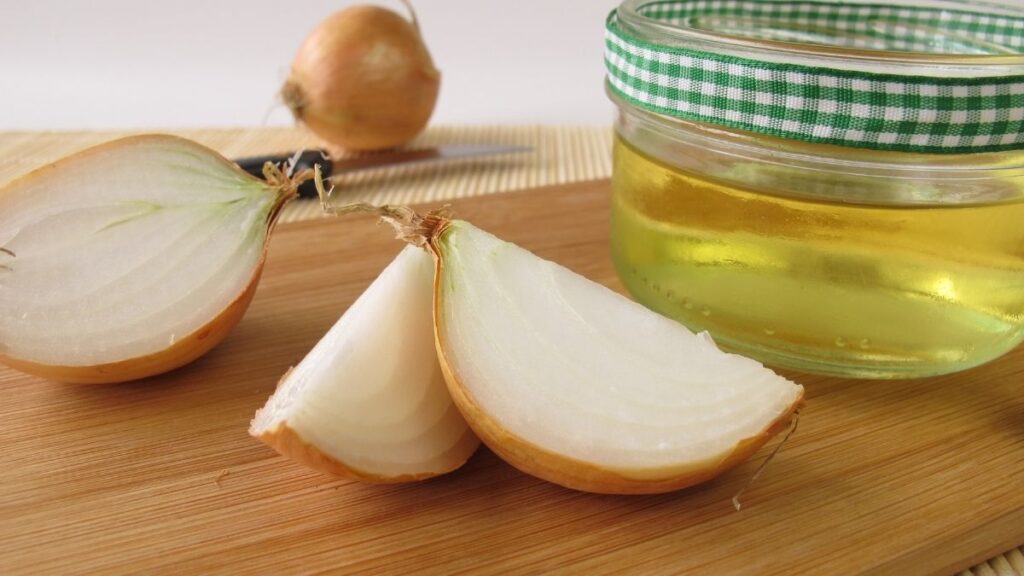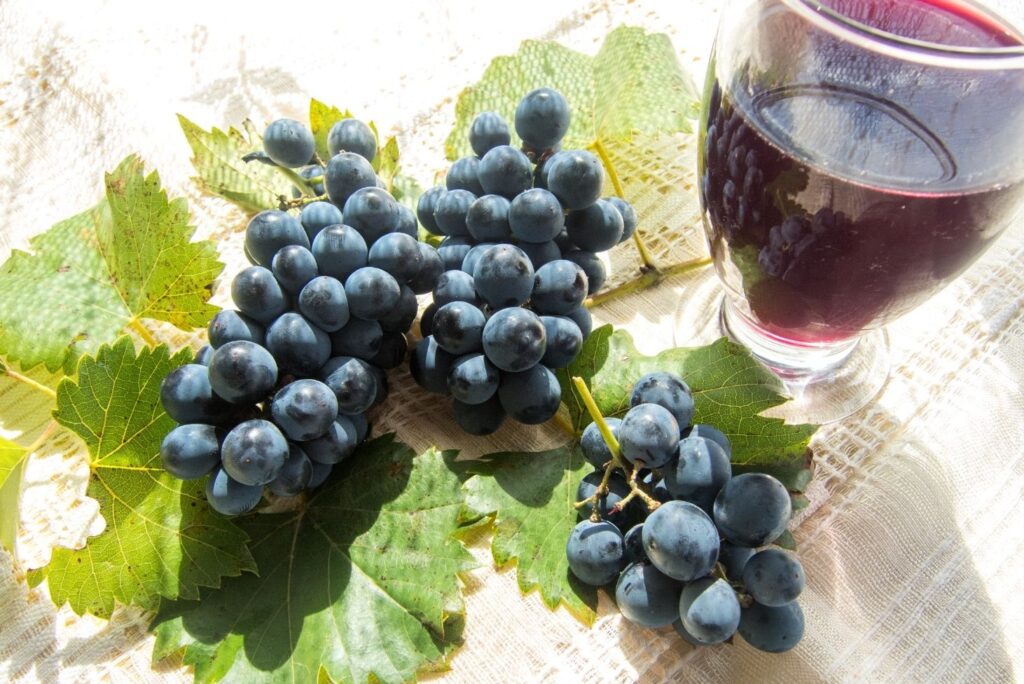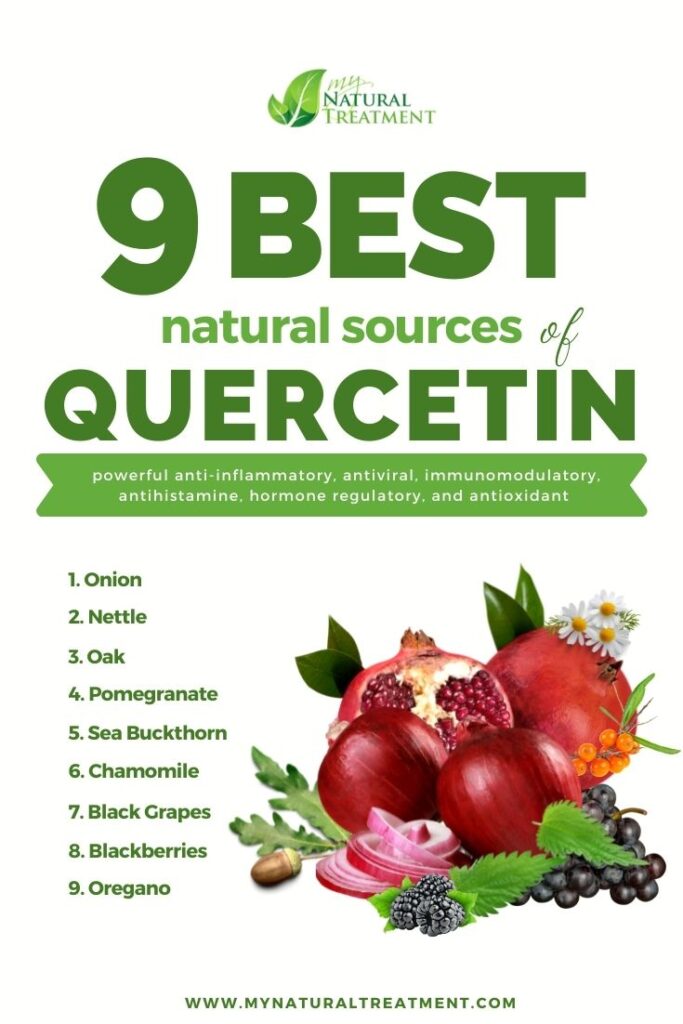Looking for the best natural sources of quercetin? Continue reading this article and find out what are the top natural quercetin sources available out there.
Quercetin is a natural bioflavonoid with powerful anti-inflammatory, antiviral, immunomodulatory, antihistamine, hormone regulatory, and antioxidant properties. It is commonly found in the natural violet pigments in the peels of black grapes and red onions, and the green pigments in the green tea leaves. Quercetin blocks histamine production, making it a powerful natural antihistamine, it also boosts the immune system and prevents cellular oxidation.

In This Article You Will Find:
Quercetin, a Short History
By the end of the twentieth century, quercitin was known by doctors as an anti-inflammatory and antihistamine and was successfully used in the treatment of diseases of the musculoskeletal system (rheumatic pain, arthritis), and respiratory system (asthma, bronchitis). Many doctors consider it a good remedy for the prophylaxis of heart disease, because of its properties to reduce the risk of thrombosis, myocardial infarction, and stroke.
In 1996, after the results of research on the anti-tumor properties of quercetin were published, quercetin gained much-appreciated publicity. The reason is quite spectacular. Scientists have discovered a unique property of this flavonoid to act on the r-53 gene, which is responsible for destroying cancer cells. In addition to prevention, quercetin can also be used to treat cancers of the breast, prostate, colon, brain, and lungs, in cases of lymphosarcoma and lymphogranulomatosis.
It is clear that we should look for natural sources of quercetin, foods, and herbs to include in our daily diet. Here are the best natural sources of quercetin to consider for regular consumption.
9 Best Natural Sources of Quercetin
1. Onion
Onion has very many medicinal properties that make it useful in treating hypertension. First of all, onion is a rich source of quercetin, which is found mainly in the onion peels. This flavonoid with a strong antioxidant action reduces the risk of heart disease and stroke. Studies confirm that quercetin prevents the clotting of blood platelets (platelets) and even prevents certain types of cancers. There is no richer natural source of quercetin than onion peel.
To make the most of it, peel an onion and make an infusion with the peels, and after it has cooled down a bit sweeten with honey. Drink warm. Or, when preparing a soup, put in it, in addition to chopped onions, the peels (possibly put them in an infuser as those used for tea). The broth will turn brown, and you will get a consistent dose of quercetin from this soup. Before serving the soup remove the peels.

2. Nettle
Dr. Andrew Weil treats his allergic rhinitis patients with nettles and quercetin instead of prednisone and other steroids. He says that at the beginning of the pollen season, one should take 400 milligrams of quercetin twice a day between meals for a week or two. It is also advisable to take one or two capsules with nettle extract at two to four hours intervals, as needed.
3. Oak
The name quercetin comes from the Latin denomination of the oak tree family Quercum. Oak acorns are particularly rich in quercetin, and you can enjoy a quercetin coffee following this recipe here. However, this flavonoid can also be found in oak leaves or bark. Studies show that oak leaf infusion has a strong antioxidant action against free radicals and protects the heart, but there are other health uses for oak, that you can read more about here.
4. Pomegranate
Also known as the “the fruit of life” and listed in the category of superfoods, pomegranate offers three times more antioxidants than red wine or green tea. It also contains three secondary active substances, considered able to slow down the aging process of the skin: apigenin, quercetin, and caffeic acid. It is true that other plants possess them in larger quantities, but the pomegranate is at the same time very rich in phytoestrogens (about twelve of them).

5. Sea Buckthorn
Sea buckthorn is very useful in kidney failure with the formation of edema, through the action of component flavones, one of them being quercetin, which produces the phenomenon of vasodilation in the kidneys, thus increasing diuresis. You can make sea buckthorn tea by scalding 1-2 teaspoons of sea buckthorn berries in a cup of hot water, and drink 2-3 cups a day.
6. Chamomile
Chamomile is known primarily for its calming action, but it also contains several anti-inflammatory compounds, such as apigenin, luteolin, and quercetin. If you make a soup with celery stalks in which you put curry (a combination of COX-2 inhibitors), you can then drink chamomile tea afterward. For ailments accompanied by pain, such as bursitis, herbalists recommend 3-4 cups of chamomile tea daily. You can also take 2-3 grams of chamomile in the form of tablets or capsules, or 4-6 ml of chamomile tincture three times a day between meals.
7. Black Grapes
Quercitin and ellagic acid are found abundantly in the black grape peels, and they have a strong antitumor effect, research in experimental medicine shows that a cure with black grapes has exceptional effects in treating cancers, preventing metastases and relapses. More so, black grapes contain resveratrol, a powerful antioxidant that prevents cellular oxidation, the main cause of rapid aging, and also boosts the immune system. There’s pretty much no reason whatsoever not to consume black grapes.

8. Blackberries
In natural medicine, the blackberry is called the immunity doctor. Not only does it stimulate the body’s ability to defend itself, but it also helps protect the body from the “slippage” of cells with a role in immunity, which translates into allergies, collagenosis, psoriasis, etc. This is due to the high content of quercetin, a substance that diminishes the allergic reaction, having antihistamine and immunomodulatory effects. In addition, blackberries also contain very large amounts of vitamin C. Eating 300-400 g of blackberries floods the body with a massive intake of this vitamin, which reduces the intensity of allergies and autoimmune reactions.
9. Oregano
Oregano contains dozens of compounds with anti-inflammatory and analgesic effects, including eight COX-2 inhibitors: apigenin, caffeic acid, eugenol, camphor, oleanolic acid, quercitin, ursolic acid, and rosmarinic acid. Of the substances listed here, rosmarinic acid is the most potent, which fights microbial or viral infections.
Other Foods Rich in Quercetin
- Fresh fruit
- Wild cranberries
- Raspberries
- Citrus fruit
- Apples
- Cherries
- Tomatoes
- Fennel leaves
- Celery
- Garlic
- Bellpepper
- Broccoli
- Asparagus
- Capers (raw)
- Beans
- Leafy greens (spinach, kale)
- Buckwheat
- Whole cereals
- Olive oil
- Carob
- Lovage
- Dill
- Cilantro
- Anise
- Sage
- Common evening primrose

Quercetin Rich Soup Recipe

Quercetin is not destroyed by cooking at high temperatures, such as boiling, so here is the quercetin soup recipe. Actually, quercetin is transferred into the soup, so a simple onion soup can easily become a superfood. Here is how to make it.
- Put a whole onion (including the peel) and a clove of garlic to a boil in a small pot.
- Add half a cup of common evening primrose leaves to the water, and the root of the plant cut into cubes (wash it well) – you can skip this part if you don’t have this plant available.
- Boil for 3 to 5 minutes, then add a cup of nettles (fresh or dried) and a cup of finely chopped celery stalks with the leaves and wait for the soup to boil for another 3 to 10 minutes on low heat.
- Finally, remove the onion peels and the quercetin soup is ready.
Eat the soup hot and seasoned to taste with pepper, turmeric, oregano, dill, hot peppers, or anything else to your liking. Serve it alongside raw onions, bell peppers, or other veggies on the quercetin foods list above. You can add some noodles to it and turn it into vegan ramen, or boiled buckwheat to give it more body and keep it gluten-free. Bon Appetit!
Read Also: 3 Highest Natural Sources of Quinine
We hope that you’ve found some good information here on the top natural sources of quinine. Let food be your medicine and health be your natural state of being. Stay healthy, naturally!


4 comments
I want to join your web. site but can’t find a place to join. Your site is perfect for me. I have dificult health challenges.. Thank you
Hi Dabbie! You can subscribe to our weekly newsletter, you find the form at the bottom of the website (scroll all the way down and you will find it). You can also find us on Facebook and Pinterest, and we also have a group on Facebook where you can join here https://www.facebook.com/groups/naturaltreatmentsandremedies/?hc_ref=ARRROj91G7E2BRj0YXvHIDW-aPrUfjXGQ-78bOr91PHi7dBvHyLN9fxU61wti8zv0Sc Thank you and I hope you find empowering information for what you need. Much health! 💚🤗
Quercetin significantly reduces high blood pressure naturally. A super beneficial flavonoid for your body. Great at fighting cancer, heart disease, and really helps people to lose weight. Truly amazing!
Thank you, Cacey for this information! Much health!🌿💚